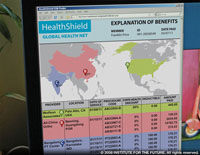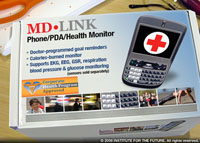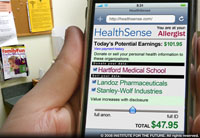Industry Compass 2.0 Health Artifacts from the Future
Industry Compass 2.0 Health Artifacts

Health Brands
What?
The convergence of health and entertainment evolves into anew market category that creates novel opportunities for consumer electronics,retail, travel, and the media industries. New and well-established brands position themselves toward health as consumers look for an explicit link between market offerings and their personal health.
So What?
What brands emerge around entertainment and health? Will these brands extend their offerings into traditional health and health care? Will new information authorities arise out of these brands? How will efficacy and health outcomes be measured? Will metrics matter?
Global Health Care

What?
The growth of health tourism continues, as options expand and more individuals decide to obtain care in high-quality, accredited facilities around the world.More online tools will be used to facilitate a comprehensive continuum ofcare—pre and post care—by connecting multiple providers and payors globally.
So What?
How will connectivity between the patient, the country of service, the local provider, and other stakeholders shape attitudes toward health tourism? How will the expansion of treatment options, using a blend of western and alternative treatments,influence the way care is delivered locally?
Health Provider Migration

What?
Stakeholders,particularly providers, face new cost and efficiency pressures as the healthcare system continues to show signs of breaking down. Concerned about potential income ceilings and the growing burden of malpractice insurance, top medical talent opt for high-end specialty clinics and other lucrative opportunities abroad.
So What?
Will more high wage jobs in emerging economies result in global, high-end concierge health programs? Will upscale domestic and foreign consumer markets be willing to pay for highly trained health care providers? How might new coordinated care models support a more global workforce?
Health Data

What?
As individuals gain more control of and electronic access to their personal health data, their ability to share this information will grow. Security standards toensure privacy will become increasingly important. New players interested incollecting, aggregating, and packaging personal health information will emerge.
So What?
How will health care data control, security, and privacy concerns be addressed? Will individuals’ understanding of privacy, along with expectations for participation and transparency, reshape health information practices? What effects might occur locally as individuals and communities obtain increased access to their own health data?
Demand for Quality

What?
Reference pricing, reimbursements tied to quality and performance,government mandates, and consumer demand indicate the need for greater transparency about outcomes. More health care consumers will associate quality and outcomes data with payments and valuation, forcing providers to guarantee the efficacy of their medical interventions.
So What?
What if at-home diagnostics and other direct-to-consumer tools for decision support are available to individuals, allowing them to measure a drug’s effectiveness? Which standards and metrics will be applied to“outcomes-based” health care, and how will they be agreed upon?
Personalized Assessments

What?
Personalized health information and individualized risk assessments come to the masses. With the dramatic reduction in size, cost, and availability of molecular diagnostic platforms, consumers can obtain a more comprehensive and biomolecular view oftheir health. This development leads to consumer-focused medical models that favor retail channels over clinicians.
So What?
What if consumers starts purchasing, with their own money, molecular diagnostic testsand “personalized” assessments of their health status? What if stakeholders resist this trend and elect to pursue legislative means to restrict direct-to-consumer marketing and sales?
Healthprint

What?
New metrics proliferate as “footprints” measure not only resources such as energy and water use but also the overall impact on the health of markets and communities. Health transparency comes to Wall Street as a company’s burden on the health care system—its “healthprint”—becomes part of the risk assessment for investment.
So What?
As more companies are implicated in the country’s health burden, will demand for policy and regulatory change increase? Who will define the newmetrics and assure quality and accountability? Will companies begin to differentiate themselves because of their low healthprint?
Health at Work

What?
Health promotion comes in new forms as consumers face added pressure to be healthy at work. Employers emphasize health maintenance, illness prevention, and productivity,and the workplace becomes a focal point for health management. Health information is collected and used to offer reinforcing incentives—for now.
So What?
What will come in the next upgrade? What workplace initiatives will result from employer staking an active role in the health management of their employees? Will more companies selling self-care services and tools focus their offerings on the employer’s interest in health promotion?
Publication Date
June 30, 2009



